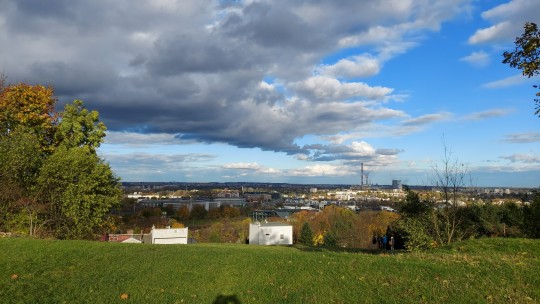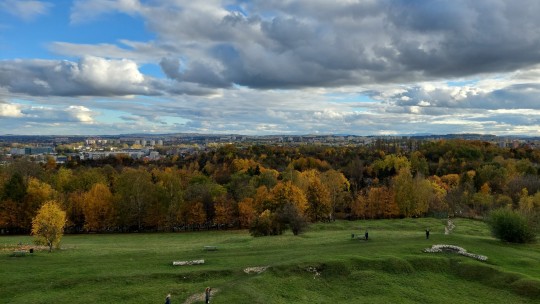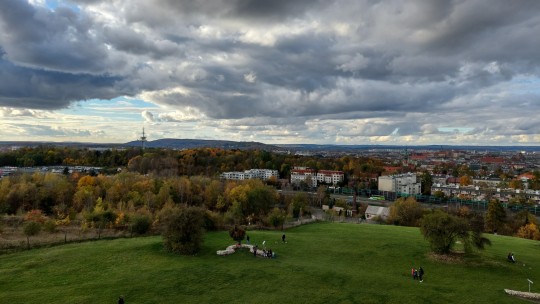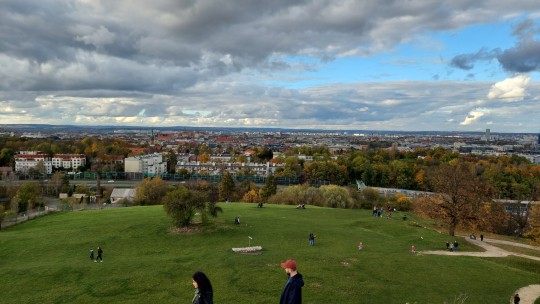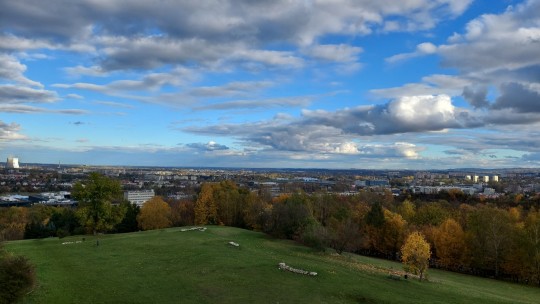#Mound Krakus
Text
Of Oak and Lyre: Before coming to the fields
Ewa lives in the cliffs. On Mound Krakus, the cliff surface turns inward at the [west] end, and then starts a new cliff surface receding deeper into the mountain [1], giving way to religious cliff caves [2]. But what happens inside the [caves] is unknown, as is the [caves’] internal structure [3]. But one thing is known to man: The [...] cave temples can be further divided into two groups: 20 caves [...] to the left and [...] on the right are another group [1].
The goddess Kali knew a tree, a tree she gifted to Ewa the day she met her, four years ago. So, naturally, so great and holy an object as [Ewa's] tree, [...] eventually found its way as a fine garden decoration [4] onto Mound Krakus. The fruit of the tree is known [5] and sacred, for nobody except Ewa is able to pick it. Visitors simply admire the big oak from afar, never coming as close as to touch its bark. In the place of the holy tree [4], Ewa comes out of her dwelling to pick the highest leaf of the oak. She chew[s] it, [doesn't] swallow it [6]. She chew[s] it both raw and boiled, though [she] swallow the juice only [7]. As she does so, every tree [of the garden] resound[s], and even the sacred oak [8].
Back in the mystic cave, the lord of the lyre and song [9] awaits her. In his long, flowing vestments, [Apollo] bridge[s] the seven distinctive notes of his lyre, which he pluck[s], now with his fingers, now with a shuttling ivory plectrum [10]. With the music of his lyre, he [is] able to stop the planets in their courses and enchant the wild [11] future. Ewa f[i]nd[s], in the resonant strings of [the] Thracian lyre, power to conjure [the future] back into existence [10]. Hard at work, she can tell a crowd is feasting [12] above, eagerly awaiting her arrival.
Once Ewa saw, she takes the stairs leading to the fields, to meet her people.
[1] Yi, Yungang Art History Archaeology Liturgy
[2] Powers, A Companion to Chinese Art
[3] Siemens, A Companion to Digital Literary Studies
[4] Gothein, A History of Garden Art
[5] Aquinas, Summa Theologica
[6] Asimov, Complete Robot Anthology
[7] Pliny, Natural History Volume 3
[8] Seneca, Complete Works
[9] Ovid, Metamorphoses
[10] Virgil, Aeneid
[11] Calasso, The Marriage of Cadmus and Harmony
[12] Homer, The Odyssey
0 notes
Text
Krakus Mound during sunset.
2 notes
·
View notes
Text
Notes on oak
Oak enjoyed a lot of reverence among the pre-Christian Slavs, especially the larger and more ancient trees. The main sanctuary of Vagrians (a Western Slavic tribe) was a sacred grove of oaks near Starigrad/Oldenburg, devoted to a little known deity Prove/Prone, which served as a place of worship and legal proceedings. A giant oak tree grew on the island of Saint Gregory (Khortycia), under which, according to Constantine Porphyrogenitus, the merchants of Rus’ made sacrifices. Another giant oak grew next to the temple of Triglav in Stettin. Traces of yet another have been found on the top of the Krakus Mound. Saxo Grammaticus claimed the image of seven-headed god of the Rani Rugiaevit was carved out of oak wood. Oak is of course also associated with the Thunderer, in Slavic context usually understood to be Perun. Countless other mentions of oak trees connected to Slavic cults can be found.
In many places people believed that harming or destroying those great ancient oaks would bring misfortune upon their community. In Kalisz region plagues were attributed to cutting down of a sacred oak (frequently a tree on which a shrine was hung). Near Nowy Targ legend held that whoever breaks a branch of great oak in Niedzica will surely die.
Oak is viewed as a quintessentially masculine tree, frequently paired with feminine linden. Oak or linden trees would often be planted by the house, to protect it and it’s inhabitants from misfortune. Both were also viewed as particularly well suited for religious purposes.
Characterized by hard and resistent wood the oak became a symbol of physical strength and invincibility as well as royal power and life. Poles used to bake bread on oak leaves, believing that whoever eats it will have oaken strength. Oak trees were used in healing rituals in which the illness could be passed onto the tree and defeated by it. In many folk tales oak was associated with raising people from the dead.
The connection between oak and thunder is obvious and apparent. Oak branches could be stuck into the thatched roofs or walls of the houses to keep the thunder away from them and prevent subsequent fires. For the same reason oak wood would be burned during thunderstorms.
The wood and leaves of an oak are a great remedy against witchcraft. Fumigations of smoke from oak leaves are believed to work well against devilish powers and cleanse air from illenesses. Oak stakes (along those made of hawthorn and aspen) were considered an excellent weapon for combating vampires, and they were sometimes pre-emptively driven into graves of hanged and drowned men, so that they couldn’t rise again and harm the community (Hrubieszów).
On the other hand oak wasn’t seen as completely benign. Witches gathered for Sabbath not only on Bald Mountains but also in oak groves. They had the ability to curse a household by sticking an oak branch into one of the house walls and ordering the family to wither as the branch itself withers. Lone oak trees growing in the fields of by the road could be seen as inhabited by the penitent spirit of a dead sinner.
Overall every oak could be seen as a dwelling place for spirits - good or bad.
In many regions of Poland, from Greater Poland to Eastern Borderlands acorns were used in fortune telling to predict the success of the next harvest, the circumstances of the coming year and potential misfortunes that might befall the community.
oak bark was used to produce black dye as well as to paint pisanki dark brown,
it was also used in tanning of animal hides,
in Lesser Poland oak would was the preferred wood for house foundations
due to it’s hardness oak was in particular associated with teeth diseases and used in curing them
Sources: Sources of Slavic Pre-Christian Religion by Juan Antonio Àlvarez-Pedrosa, Slavonic Pagan Sanctuaries by Leszek Paweł Słupecki, Rośliny w wierzeniach i zwyczajach ludowych. Słownik Adama Fischera by Kujawska et. al, Obraz dębu i lipy w literaturze polskiej i litewskiej XIX - XX wieku. Studium porównawcze. by Stanisława Gajewska, The symbolic meaning of plants grown in a traditional homestead by Małgorzata Dróżdż-Szczybura, Społeczeństwo wobec przyrody – związki przyrody z człowiekiem w zwyczajach ludowych w Polsce i wybranych krajach Europy by Joanna Szmuc
140 notes
·
View notes
Text







A few from my wandering around Krakow today -
First up was an hour’s walk to Krakus Mound which literally (as you can see from the first picture) has an additional mound on top of the hill 😄, and the area gives you a fantastic 360 degree view of the city. I’m really glad I had a fairly early start to the day because it got HOT around the time I got to the top - 30+ degrees hot. Afterwards I walked to the old town where the cloth hall, Rynek square, St. Mary’s Cathedral, St. Florian’s gate, etc. are all located. Favourite part? Walking through random streets admiring all the pretty buildings, of course!
My last stop before heading to the airport was Wawel’s castle. While I didn’t go into the many buildings that are within the complex, I did circle around and spend some time in Wawel’s cathedral, which provided some interesting history I wasn’t aware of before. All in all, and with yet another delayed flight back to the Netherlands, an excellent weekend nonetheless!
5 notes
·
View notes
Photo




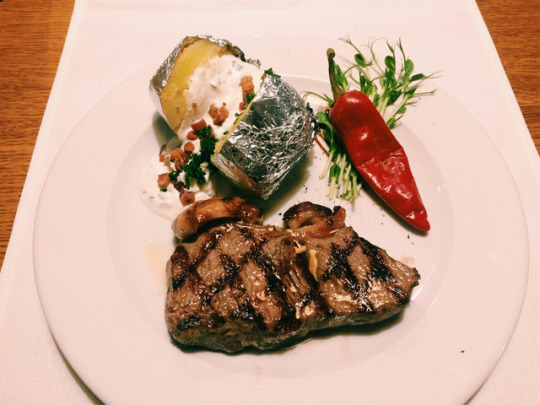
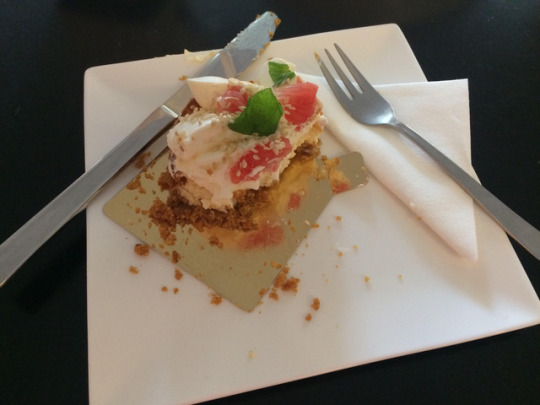


Mini-photo dump with a long post because I’m going to Berlin tomorrow (for the first time ever) (to hang out with one of my best friends) (!!!!!!!!) and will not be blogging over the weekend. These are all from yesterday and today, two very lovely days (except for the part of yesterday where I forgot to ate lunch and was stupidly hangry by dinnertime).
I learned the phrase “Złota Polska Jesień,” which means “Golden Polish Autumn” and is what this type of beautiful weather at this time of year is called. Yesterday I took advantage of the weather and climbed Krakus Mound, which was possibly the most amazing thing I’ve done yet here--the structure itself is so cool and has a really interesting history. That picture of me
is atop Krakus Mound, with Kraków in the background.
The first photo is of a sign in the window of a cab; I was amused by it.
The two photos of trees were both around Krakus Mound.
The steak I ate last night, at an Argentinian steakhouse. I’ve been craving steak for days, and I walked around so much yesterday that I felt like I deserved a splurge. You might be surprised to hear of a quality Argentinian steakhouse in Kraków, but it was totally fantastic. I got a beautiful salad, a steak, and a baked potato all for about $28. A splurge on the złoty is barely a splurge.
The last three photos are from today. I didn’t do much in the morning, but then in the afternoon I felt like exploring a little.
I came across this French patisserie online and decided to go there; it’s located next to Rynek Podgórski, the main square in Podgórze, a small district south of the river. The highlight of Rynek Podgórski is St. Joseph’s Church, in the next photo.
This patisserie was really the highlight for me, though. I mean, I like beautiful churches, but I love cheesecake, especially this cheesecake; it was incredibly light, and very slightly grapefruit-flavored, with a mint cream on top, mint leaves, and pieces of grapefruit. It was barely sweet and so delicious. And the woman who was working there (and who I presume is one of the owners) is actually French, and I got to speak a little French for the first time in years.
The last photo I just snapped on my walk home, this city is full of elegant buildings and everything looks particularly beautiful at dusk.
I promise a full download when I come back from Berlin! Until then!
#Krakow#Poland#travel#travel blog#cheesecake#teatime#patisserie#steakhouse#steak#church#Krakus Mound#autumn#Golden Polish Autumn#beautiful#photos#dusk
14 notes
·
View notes
Text
If I may add a small handful of academic commentaries for @vigilantsycamore re: origin & dating of Polish legends:
(English) Juan Antonio Álvarez-Pedrosa, Krakow’s Foundation Myth: An Indo-European theme through the eyes of medieval erudition, in: The Journal of Indo-European Studies, Vol. 37 (2009), No. 1-2
(English) Leszek Paweł Słupecki, The Krakus’ and Wanda’s Burial Mounds of Cracow, in: Studia Mythologica Slavica, Vol. 2 (1999) (You may be interested in more from this journal.)
(English) Leszek Paweł Słupecki, Vanda Mari, Vanda Terrae, Aeri Vanda Imperet : the Cracovian Tripartie Earth-Heaven-Sea Formula and Her Old-Icelandic, Old-Irish and Old-High-German Counterparts, in: Światowit, Vol 40 (1995)
(Polish) Kazimierz Feliks Kumanecki, Podanie o Wandzie w świetle źródeł starożytnych, in: Pamiętnik Literacki, 1925-26
(Polish) Lech Leciejewicz, Legendy etnogenetyczne w świecie słowiańskim, in: Slavia Antiqua, Vol. 32 (1989/1990)
All of those have further bibliographies on the matter included, too.
—
Amazing, thank you so much @life-of-architecture ! @vigilantsycamore you should check them out :)
57 notes
·
View notes
Text
Noc Kupały - Noc Świętojańska
Well, let’s write about another polish tradition. I mean, the night 23/24 of June is famous in many countries. So let’s see what’s going on that night in Poland.
Let me explain why I put 2 names.
Noc Kupały (Ivanа-Kupala) - 21/22 of June, the shortest night - pagan Slavic holiday.
Noc Świętojańska (Saint John's Eve) - 23/24 of June - catholic celebration.
Nowadays it’s one event. Christians couldn’t destroy pagans ceremonies so they changed names of them and a little bit the character and the objectives. It was easier than prohibit to celebrate it.
So the catholic festive - nothing interesting, I’ll describe more Noc Kupały, the pagan day because it was first and has its craziness. Ant my description is about traditions in Kraków because they’re quite different in the others parts of Poland.
And I’ll describe it basing on my own experience XD
The day starts with the sunrise! The most famous sunrise in Kraków. It’s obligatory to go to Krakus Mound to see it. But be early enough to take a spot - thousands of people will be there as well! And good luck with the weather xD
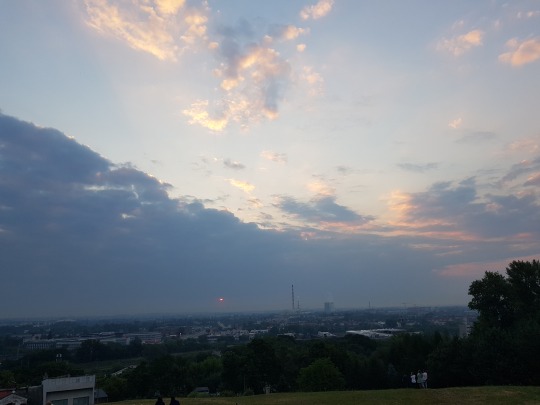

But at least before was nice!

sleeping is for weak people.
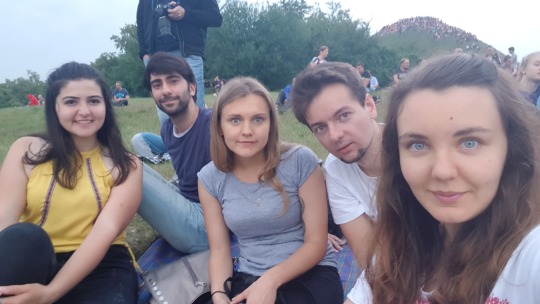
Look above my head xD you see? those dots are people on the mound xDDD


Ok, so this is the morning spirit. In Kraków there are 4 mounds and this one with Wanda Mound are for sunrises and sunsets. I mean, the sun goes down/up once a year above one of them when you are looking from the other one #magic.
In Kraków there is an organization which tries to keep the pagan ceremonies alive.
So in the afternoon/evening in the same Mound there was another event. And it was crazy. We met in this park next to the mound, many people were dresses in white clothes, like in the past times. Even me! I was prepared xD

Slavic doe! (Córa wódy, oczyszczona łania słowiańska).
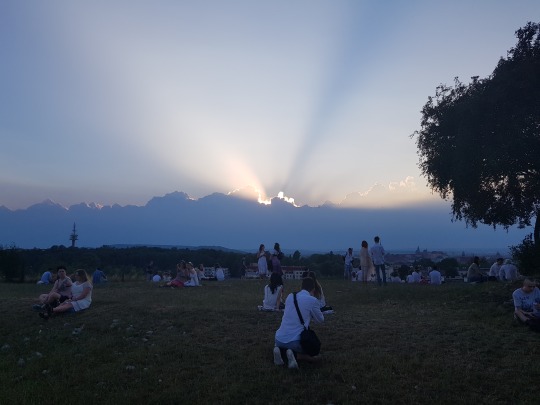
Maybe you already know, or not, but people were drinking (illegally of course). And the best should be mead (miód pitny) but Soplica lemon and honey was good too. And the organizers had the best costumes xD (and they were for sure -> song).
When we were a loooot, they started. First some organizing words and then we started to going down to the forest (old quarry - kamieniołom). It was quite creepy xD Alone for sure I would never have gone there. And it was darker and darker.
And there was small square, everything already prepared. The day before they upload on the event a “songbook”.
What do I mean by “everything prepared”? Well, the night was about praying to the pagan gods, especially to the ones responsible for fire and water. It was about catharsis!
The night is full of the fireworks. And the first one is a burning figure of one of the gods. We should have brought some food like apples, bread to “give it” to the god as a sacrifice.
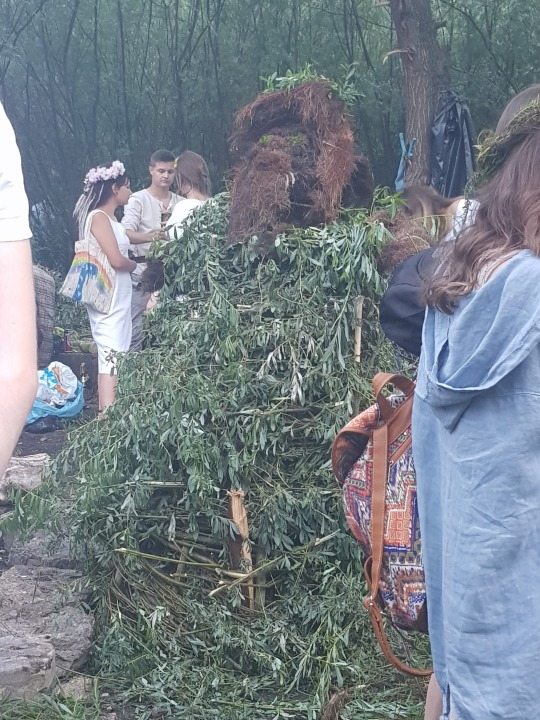
They asked people to make circles - around it and also they asked for volunteers to be in the first circle, the closest one. And because I was with my Erasmus friend who was super excited about this “tradition”, we went to be there, in the first line... It was creepy crazy. And the lyrics from the songbook... I couldn’t read it, I felt like I was calling demons 🙈
And the storm came! With huge lightning!!! They put the fire to the monument and it was quite dangerous for us in the first line xD We run away (like in Fallas...).
Here is a short example how it was xDDD
youtube
We didn’t stay long, because of the weather. The rain started on our way back from the forest. And this wind... MASAKRA hahaha I remember I just stopped and started laughing like stupid because of this tragic situation.

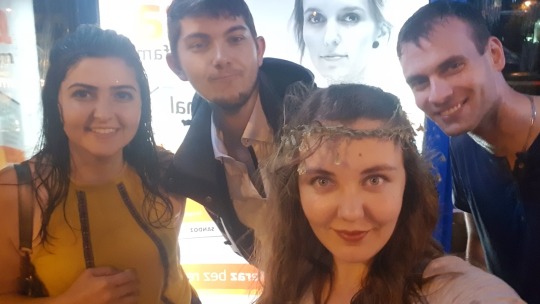
So this was my experience. Let’s write more about the tradition.
Wreaths
Like you see my head in the photo above, girls should have wreaths (thanks man for that one xD). Why? Girls make those wreaths from magic herbs, and later they throw it to the river. few meters further there are boys who are trying to catch them. And this is how couples are made xD If nobody catch some wreath - the girl will get married soooo late, if the wreath goes under - loneliness or death. #lifeIsBrutal
Predictions
Of course all about love future life. Who with who, when, where. Predictions with herbs, flowers and water.
Campfires
Jumping through the fire and dancing around are to protect from illnesses etc.
Flower of Fern
The most important one! The legend says that this night the fern blooms! If you find the flower of the fern you will be rich (I’m not rich but I live like a millionaire). But the truth is different. The flower was just an excuse to go to the forest and make looooove ;) In those times it was illegal before the wedding! But this night was magic... and they were just looking for the flower!
Ok. That’s all. Sounds crazy, I know. It was creepy experience in my life xD
And the more you read about Noc Kupały the more it’s destroying your mind.
I’ll leave you with polish band - Żywiołak. They sing about those pagan traditions. Sorry it’s in Polish. But has English subtitles!
youtube
10 notes
·
View notes
Photo

The oldest structure in #Krakow, Krakus Mound is one of two prehistoric monumental mounds in the city and is also its highest point, providing incredible panoramic views from its sixteen-metre high summit. 📌 bit.ly/KrakusMound #traveltip #travelslow #travelsmart #travelguide #krakowinyourpocket #krakow101 #visitkrakow #visitpoland #polandexperience #travelpoland #traveleurope #lovetotravel #sightseeing #traveldestination #poland #seekrakow #traveladdict #poland🇵🇱 #polska #cracow
3 notes
·
View notes
Text
Kamil's story
The funicular ride I took uphill brought me to the place known as [Kali’s] Garden of [Eden], where wild roses grow and every single bush bears sixty blooms, with the sweetest scent of any flowers anywhere [1]. On my way up, the hustle and bustle of the city below grew fainter and the sumptuous greenery of the surrounding hillsides came into view.
In front of my eyes was a garden, and what a garden [2]! Beautiful pictures [of] herbaceous lupins, pink, yellow, mauve, and other colours, [...]; myosotis [...], giving spring carpets of their precious blue in bulb and other beds; giant pansies, white, primrose, mauve, purple, and other shades; [...] perennial poppies of the orientale and bracteatum types, having giant flower stems [...]; double and single giant pyrethrums, having [...] masses of beautiful flowers; scarlet, white, pink, purple and rose Brompton stocks [3]. The air heavy with the delicate scent of pink blooms of hibiscus and orchids, springs of joy murmur on every side [4]. Butterflies fluttering daintily from bloom to bloom, their wings a riot of vibrant hues. Soft, velvety moss growing luxuriantly around majestic trees with sprawling canopies. The garden’s flowers breathed perfume and its birds warbled amid the bloom as it were a garden of the gardens of Paradise [2]. This garden [did] not whet your appetite; it quenche[d] it [5].
As I lingered, marvelling at the kaleidoscope of colours that surrounded me, I could discern a soft melody in the distance. And behold, up came dancers and drummers with their drums and pipers with their pipes, [...] and played all manner antics with voice and limbs [6]. The placid serenity from moments prior had suddenly bloomed into a symphony above [the branches], a beating of drums below [the moss], dances, joyous faces [...], songs, [...] and frank laughter [7]. All gathered by a field which stretched to the brink of a brusque cliff. As the crowd stood motionless, the stillness broken only to the gentle flutter of dragonfly wings, moments stretched into minutes. Finally, a delicate silhouette ascended the stairs leading up the cliff face.
‘Who is she?’, I asked my neighbour.
‘Newcomer I see’ he said, ‘You have been in Eden, the garden of [the] God[s][8], Kali and Apollo. You have joined to meet the oracle, Ewa. Now observe and talk not’.
It all made sense. Hence [faces] splendid with both [smile] and [laughter]; [...] hence the zither and lyre and drums [9]. Hence the dances and cheering.
The oracle’s eyes, dark and deep as a starless night, observed the masses with a calm intensity that belied the seriousness of her task. As her body swayed slightly, behind her, her long robes flowed in the wind. And then, a powerful voice bloomed from her lips:
‘[Kali and Apollo are] wise [11], so pray to the Winds [10]’ she spoke, ‘They will prove to be mighty allies of [Krakow] [10]. [Jack] is wiser [11], so, love of money and nothing else will ruin [Krakow] [12]. But of all men [you are] wisest [11], so make your own nature, not the advise of others, your guide in life [13]. Also the dragon, earthborn, in craftiness coming behind thee [14]. Your presence here outrages the God[s] [15] who offended you. Don’t go back, matricide [15]! The names Shiva, Argus and Pinterest mark the hour of your downfall [15]!’.
Ewa’s words rang out across the garden, her voice carrying the weight of the prophecy. The crowd listened in rapt attention, knowing that her words carried the authority of the divine.
She turned around and vanished down the face of the cliff. My neighbour, much like everyone else around me, seemed to have heared the true answer to [their] question [16], a question that only those of Krakow appeared to have pondered.
As I retraced my steps towards the city, I knew I had visited the Garden of Eden upon the earth, birth place of the fairies: I will never forget thy beauties, O [Krakow], for none but thee will I ever long:— Blessed be the wonders that glitter on thy [meadows] [6].
[1] Herodotus, The Histories
[2] The Book of the Thousand and One Nights
[3] Gothein, A History of Garden Art
[4] Wollstonecraft, Complete Works
[5] Seneca, Complete Works
[6] The Book of the Thousand and One Nights Supplementary Nights
[7] Hugo, Les Misérables
[8] Augustine, The City of God
[9] Melanchthon Bucer, Collected Works
[10] Macaulay, G. C., Herodotus Book VII
[11] Nietzsche, The Birth of Tragedy and Other Writings
[12] Diodorus VII.12.5
[13] Ciero
[14] Plutarch, On the Pythian Responses
[15] Markville History, World History to 16th Century
[16] Aquinas, Summa Theologica
1 note
·
View note
Text

Krakus Mound, Krakow, Poland.
1 note
·
View note
Photo

Krakus Mound (Kopiec Krakusa), also called the Krak Mound, is a tumulus located in the Podgórze district of Kraków, Poland; thought to be the resting place of Kraków's mythical founder, the legendary King Krakus. It is located on Lasota Hill, approximately 3 kilometres south of Kraków's city centre, at an altitude of 271 metres, with a base diameter of 60 metres and a height of 16 metres. Together with nearby Wanda Mound, it is one of Kraków's two prehistoric mounds as well as the oldest man-made structure in Kraków. Nearby are also two other non-prehistoric, man-made mounds, Kościuszko Mound, constructed in 1823, and Piłsudski's Mound, completed in 1937. These four make up Kraków's four memorial mounds. . @krakow_pl @visitkrakow @igerspoland @krakowcityguide @beautifuldestinations @bestvactions @ig_shotz @travelandlife @worldplaces @travelandleisure @awesome.earth @living_destinations @travelanddestinations @fantastic_earth @wonderfulplaces @travelawesome @passionpassport @awesomeglobe @travellingthroughtheworld @discoverearth @eclecticshotz @theglobewanderer @nakedplanet @earthpix @earthfocus @wanderlustinitative (at Kopiec Krakusa) https://www.instagram.com/p/CHkYJ_YgUim/?igshid=1vxsjhag4fncj
0 notes
Text
Banquet of the Beasts
Jack ma invites his friends to talk cityness, and how Krakow has forgotten its beast, on top of the mound Krakus.
the prosperous serpentine — the sanguine jaguar — the cunning raven — the meddlesome rat
the serpentine
- cold, greedy, narcissistic
- skin & chemicals
Glimmering shiny scales, the serpentine always prepares for its next win. It choose expensive clothes often make the impression of an arrogant arrogance. Being its friend is often hard. They can't accept criticism, and someone else's opinion means little.
the jaguar
- fuzzy, impulsive, driven
- hair & mouth
The shyest of the quartet, however the jaguar is adorned in loud speckles. Though introverted, it is not fearful of any risk. Its stealth and determination guarantees its place in the world.
the raven
- intelligent, curious, opportunistic
- feathers & eyes
The knowledgeable raven offers a birds eye view of things, giving perspective from another angle. Though enlightened with its resources, its all-black look can appear eccentric or intense.
the rat
- unpopular, adaptable, muddy
- ears & nose
The nosy rat, though lacking courage, seems to always get its way round knowing everybody’s business. Its strong importance towards family may seem like a rat is a loyal friend, but be warned, the rat always gets what it wants.
0 notes
Photo

Krakus Mound | Potevo portarmi gli sci a questo punto .. 😁 . .
Vanessa ( @laviniavane )
7 notes
·
View notes
